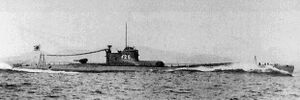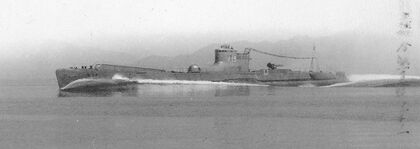Type B1 submarine
Topic: Engineering
 From HandWiki - Reading time: 6 min
From HandWiki - Reading time: 6 min
 I-26
| |
| Class overview | |
|---|---|
| Name: | B1 class |
| Operators: |
|
| Preceded by: | Type J3 submarine |
| Succeeded by: | Type B2 submarine |
| Completed: | 18 |
| Lost: | 17 |
| Scrapped: | 1 |
| General characteristics | |
| Class and type: | Cruiser submarine |
| Displacement: |
|
| Length: | 108.7 m (356 ft 8 in) overall |
| Beam: | 9.3 m (30 ft 6 in) |
| Draft: | 5.1 m (16 ft 9 in) |
| Installed power: |
|
| Propulsion: |
|
| Speed: |
|
| Range: |
|
| Test depth: | 100 m (330 ft) |
| Crew: | 94 |
| Armament: |
|
| Aircraft carried: | 1 × floatplane |
| Aviation facilities: | 1 × catapult |
The Type B1 submarine (巡潜乙型潜水艦 Junsen Otsu-gata sensuikan, lit. "Cruiser submarine type B"), also called I-15-class submarine (伊一五型潜水艦 I-jū-go-gata sensuikan) was the first group of boats of the Type B cruiser submarines built for the Imperial Japanese Navy (IJN) during the 1940s. In total 20 were built, starting with I-15, which gave the series their alternative name.
Design and description
The Type B submarines were derived from the earlier KD6 sub-class of the Kaidai class and were equipped with an aircraft to enhance their scouting ability. They displaced 2,631 tonnes (2,589 long tons) surfaced and 3,713 tonnes (3,654 long tons) submerged. The submarines were 108.7 meters (356 ft 8 in) long, had a beam of 9.3 meters (30 ft 6 in) and a draft of 5.1 meters (16 ft 9 in). They had a diving depth of 100 meters (330 ft).[1]
For surface running, the boats were powered by two 6,200-brake-horsepower (4,623 kW) diesel engines, each driving one propeller shaft. When submerged each propeller was driven by a 1,000-horsepower (746 kW) electric motor. They could reach 23.6 knots (43.7 km/h; 27.2 mph) on the surface and 8 knots (15 km/h; 9.2 mph) underwater.[2] On the surface, the B1s had a range of 14,000 nautical miles (26,000 km; 16,000 mi) at 16 knots (30 km/h; 18 mph); submerged, they had a range of 96 nmi (178 km; 110 mi) at 3 knots (5.6 km/h; 3.5 mph).[3]
The boats were armed with six internal bow 53.3 cm (21.0 in) torpedo tubes and carried a total of 17 torpedoes. They were also armed with a single 140 mm (5.5 in)/40 deck gun and two single mounts for 25 mm (1 in) Type 96 anti-aircraft guns.[3] In the Type Bs, the aircraft hangar was faired into the base of the conning tower. A single catapult was positioned on the forward deck. Late in the war, some of the submarines had their aircraft hangar removed, to replace it with an additional 14 cm gun. In 1944, I-36 and I-37 had their aircraft hangar and catapult removed so that they could carry four Kaiten manned torpedoes, with I-36 later being further modified to carry six.[3]
Service
The series was rather successful, especially at the beginning of the war.
- I-17 shelled an oil field up the beach from Santa Barbara and damaged a pump house in Elwood in February 1942. She was sunk by the New Zealand trawler Tui and two US Navy aircraft off Noumea on 19 August 1943.
- On 15 September 1942 I-19 fired six torpedoes at the aircraft carrier USS Wasp, three of which hit the carrier and sank her. The three remaining torpedoes went on for several thousand meters and hit another carrier force,[citation needed] damaging the battleship USS North Carolina and sinking the destroyer USS O'Brien. I-19 was sunk with depth charges by USS Radford[4] on 25 November 1943.
- I-25 conducted one of the few attacks on the continental United States in September 1942. A year later she was sunk by destroyer USS Patterson off the New Hebrides on 3 September 1943.
- I-26 sank the US Army chartered merchant ship SS Cynthia Olson about 1,000 miles northeast of Pearl Harbor on 7 December 1941, causing 35 fatalities. She also crippled the aircraft carrier USS Saratoga with one torpedo hit (out of six fired) on 31 August 1942. On 13 November 1942, she sank the cruiser USS Juneau. She was sunk off Leyte in October 1944.
- I-27 Between June 1942 and February 1944, she sank several ships including: SS Iron Crown near Gabo Island, SS Fort Mumford and SS Montanan in the Indian Ocean, Liberty ship SS Sambridge, and the SS Khedive Ismail near the Maldives on February 12, 1944. Following her last success, she was sunk by escorting British warships.
- I-29 was used to conduct personnel, gold, and technology exchanges with Germany during WW2. Her most famous Yanagi mission was the successful transfer on 26 April 1943 off the coast of Mozambique, Africa, and safe return to Japan from German U-180 with Netaji Subhas Chandra Bose, leader of the Indian Independence Movement and Indian National Army who was going from Berlin to Tokyo, and his Adjutant, Abid Hasan, while two Japanese naval officers sent to study U-boat construction and 2 tons of gold were transferred to U-180 as Japanese payment for German wartime technology. Both submarines returned safely to their bases.
- I-39 on 12 September 1943, torpedoed the 205 ft fleet tug USS Navajo en route from Pago Pago towing a gas barge.
Losses

- I-15 was sunk off San Cristobol on 2 November 1942 by destroyer USS McCalla.
- I-19 was sunk by USS Radford 25 November 1943
- I-21 made her final report on 27 November 1943, off the Gilbert Islands, following which she was never heard from again.[5] At least one source attributes her sinking to aircraft from escort carrier USS Chenango on 29 November 1943.[6]
- I-23 was lost in February 1942, following a final report made from off Oahu.
- I-25 was sunk by USS Patterson on 25 August 1943.[citation needed]
- I-27 was sunk by the British destroyers HMS Paladin and HMS Petard off Addu Atoll on 12 February 1944 after it had sunk the troopship SS Khedive Ismail with the loss of about 1,300 lives. She was first rammed by Paladin then torpedoed by Petard.[5]
- I-28 was sunk by submarine USS Tautog south of Truk on 17 May 1942.
- I-29 was sunk by USS Sawfish in Balintang Channel on 26 July 1944.
- I-30 was the first Japanese submarine to reach Europe under the Yanagi missions, but she was sunk by a mine off Singapore on 13 October 1942.
- I-31 was sunk by destroyers USS Edwards and USS Frazier off Attu on 12 May 1943.
- I-32 was sunk by the destroyer escort USS Manlove and the subchaser USS Canastota south of Wotje on 24 March 1944.
- I-33 was lost during sea trials in the Inland Sea on 13 June 1944.
- I-34 was sunk by submarine HMS Taurus off Penang on 13 November 1943.
- I-35 was sunk by destroyers USS Meade and USS Frazier off Tarawa on 23 November 1943.[7]
- I-37 was sunk by destroyer escorts USS Conklin and USS McCoy Reynolds off Leyte on 19 November 1944.
- I-38 was sunk by destroyer USS Nicholas near Yap on 12 November 1944.
- I-39 was sunk by destroyer USS Boyd in the Gilberts on 26 November 1943.
Altogether the Type B submarines (B1, B2, and B3 combined) are credited with sinking 56 merchant ships for a total of 372,730 tonnes, about 35% of all merchant shipping sunk by Japanese submarines during the war.
All B1 type submarines were lost during the conflict, except for I-36, which was scuttled off Gotō Islands by the US Navy on 1 April 1946.
See also
Notes
- ↑ Bagnasco, p. 189
- ↑ Chesneau, p. 200
- ↑ 3.0 3.1 3.2 Carpenter & Dorr, p. 102
- ↑ Cressman, Robert (2000). "Chapter V: 1943". The official chronology of the U.S. Navy in World War II. Annapolis, Maryland: Naval Institute Press. ISBN 978-1-55750-149-3. OCLC 41977179. http://www.ibiblio.org/hyperwar/USN/USN-Chron/USN-Chron-1943.html. Retrieved 2012-09-14.
- ↑ 5.0 5.1 Boyd, Carl; Akihiko Yoshida (2002). The Japanese Submarine Force and World War II. Naval Institute Press. ISBN 1-55750-015-0.
- ↑ Rohwer, Jürgen; Hümmelchen, Gerhard (2005). Chronology of the War at Sea, 1939–1945: the Naval History of World War Two (3. rev. ed.). Annapolis, Md.: Naval Institute Press. p. 289. ISBN 9781591141198. https://books.google.com/books?id=TpDlFI453RcC.
- ↑ report of the sinking of I-35, Department of Defence (Australia), undated World War II, accessed 24 April 2010
References
- Bagnasco, Erminio (1977). Submarines of World War Two. Annapolis, Maryland: Naval Institute Press. ISBN 0-87021-962-6.
- Boyd, Carl; Yoshida, Akikiko (2002). The Japanese Submarine Force and World War II. Annapolis, Maryland: Naval Institute Press. ISBN 1-55750-015-0.
- Carpenter, Dorr B.; Polmar, Norman (1986). Submarines of the Imperial Japanese Navy 1904–1945. London: Conway Maritime Press. ISBN 0-85177-396-6.
- Chesneau, Roger, ed (1980). Conway's All the World's Fighting Ships 1922–1946. Greenwich, UK: Conway Maritime Press. ISBN 0-85177-146-7.
- Hashimoto, Mochitsura (1954). Sunk: The Story of the Japanese Submarine Fleet 1942 – 1945. Colegrave, E.H.M. (translator). London: Cassell and Company. ASIN B000QSM3L0.
- Milanovich, Kathrin (2021). "The IJN Submarines of the I 15 Class". in Jordan, John. Warship 2021. Oxford, UK: Osprey Publishing. pp. 29–43. ISBN 978-1-4728-4779-9.
- Stille, Mark (2007). Imperial Japanese Navy Submarines 1941-45. New Vanguard. 135. Botley, Oxford, UK: Osprey Publishing. ISBN 978-1-84603-090-1.
 |
 KSF
KSF